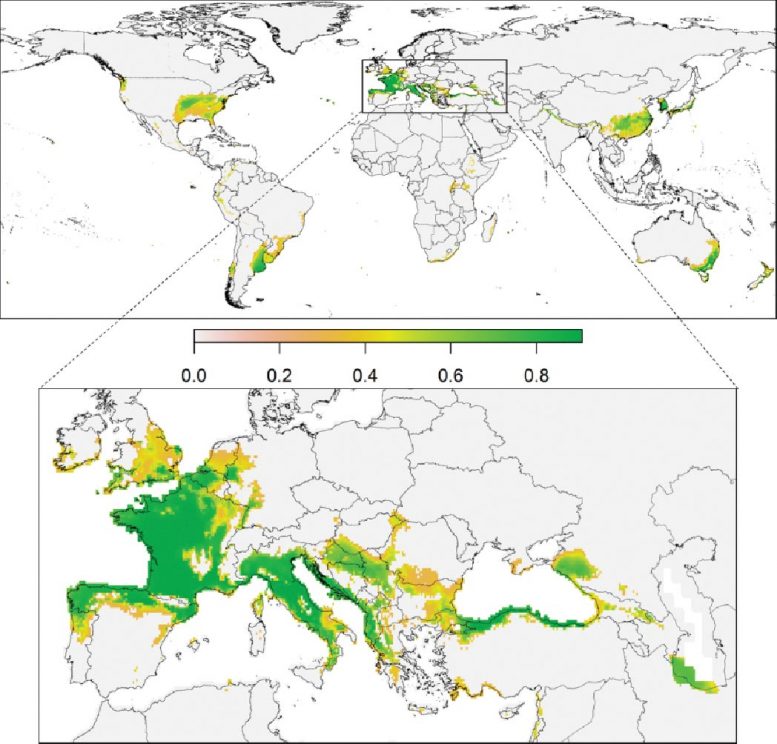
Consensus climate suitability of the yellow-legged hornet predicted from species distribution modeling. Credit: Prof. Franck Courchamp
Since its accidental introduction in 2003 in France, the yellow-legged Asian hornet (Vespa velutina nigrithorax) is rapidly spreading through Europe. Both experts and citizen scientists keep on identifying the new invader spreading all over the Old Continent in the last decades.
In a recent study, French scientists led by Prof. Franck Courchamp at the Université Paris-Saclay and the CNRS, tried to evaluate the first estimated control costs for this invasion. Supported by the INVACOST project, their findings are published in the open-access journal NeoBiota.
Since its invasion to France in 2004 when it was accidentally introduced from China, the Asian hornet has been spreading rapidly, colonizing most of France at an approximate rate of 60-80 km per year, and also invading other European countries: Spain in 2010, Portugal and Belgium in 2011, Italy in 2012, Germany in 2014 and the UK in 2016. In the recent paper, published in the open-access journal Evolutionary Systematics, Dr. Martin Hussemann from CeNaK, University of Hamburg has recorded the northernmost capture of the Asian hornet in Hamburg in September 2019.
These data show that the Asian hornet is spreading all around Europe faster and faster with every year, even in climatically less favorable regions. The rapid invasion of the species is not necessarily caused by human-mediated dispersal, the species can rapidly spread on its own, but nevertheless, it is not uncommon.
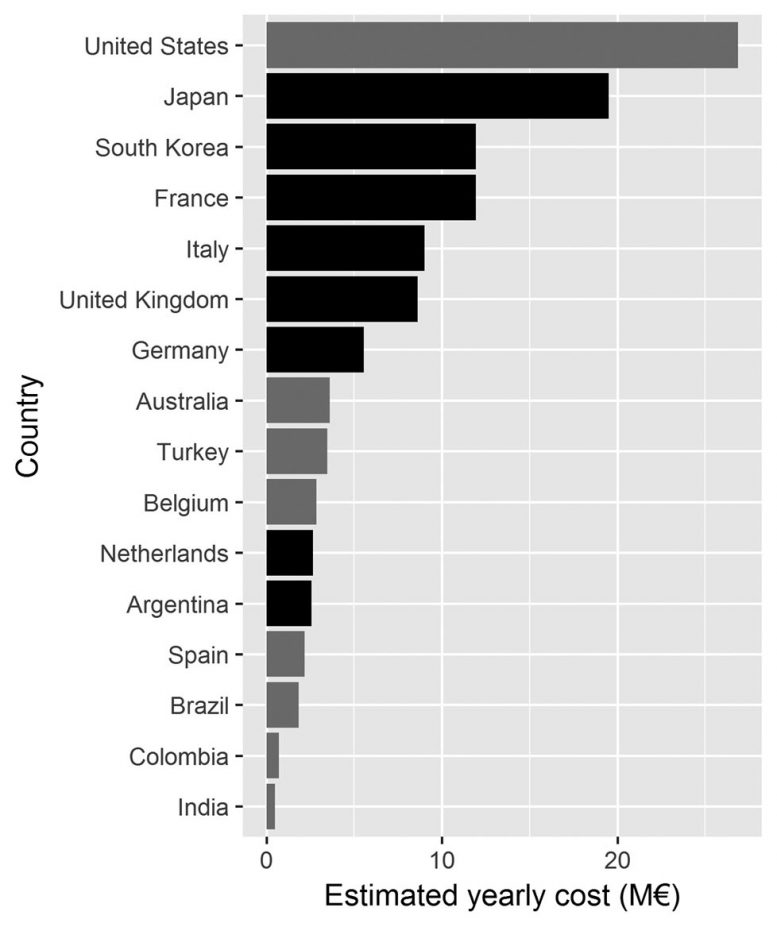
Estimated yearly cost of nest destruction if climatically suitable areas are fully invaded. Grey bars represent countries invasion hasn’t reached yet. Credit: Prof. Franck Courchamp
Within its native and invasive range, V. velutina nigrithorax actively preys on honeybees, thus, causing harm to apiculture. Due to its active praying on wild insects, the Asian hornet also has a negative impact on ecosystems in general and contributes to the global decline of pollination services and honey production. Furthermore, by nesting in urban areas, the Asian hornet, which is well known for its aggressive behavior, is a potential threat to human activities.
Currently, the control of the invasion is mainly undertaken by nest destruction and bait trapping, but none of these methods is sufficient enough to achieve complete eradication.
To proceed with further control of the invasion, there is a need to evaluate economic costs. Those costs are divided into 3 main categories: (1) prevention of the invasion, (2) fighting the invasion, and (3) damage caused by the invasion.
The cost of fighting the invasion of the Asian hornet is the cost of nest destruction. To identify those costs, the research team has studied information about the companies providing the services in nest destruction, extrapolated the cost of nest destruction spatially, and modeled the potential distribution of the invasive.
As the calculations show, at the moment, the estimated yearly costs for eradication would be €11.9M for France, €9.0M for Italy, and €8.6M for the United Kingdom.
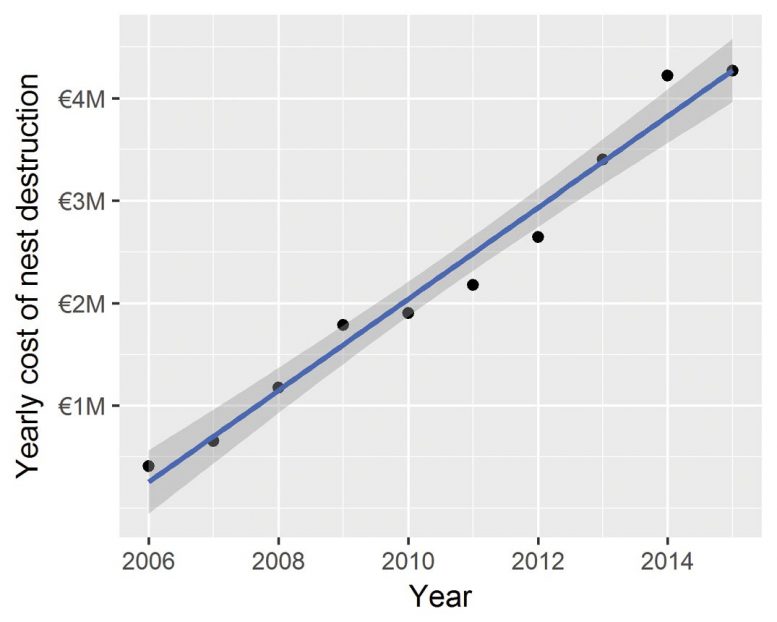
Estimated yearly cost of nest destruction in France since the start of the invasion given the yearly invasive range. Credit: Prof. Franck Courchamp
“In 2006, only two years after the hornet was first observed in France, three departments were already invaded and the cost of nest destruction was estimated at €408k. Since then, the estimated yearly costs have been increasing by ~€450k each year, as the hornet keeps spreading and invading new departments. Overall, we estimated €23M as the cost of nest destruction between 2006 and 2015. If this temporal trend can be extrapolated for the next few years (i.e. if the hornet keeps spreading at a similar rate), we expect the yearly cost of nest destruction to reach an estimated value of €11.9M (given all suitable areas are invaded) in just 12 years,” shares Prof. Franck Courchamp.
In Japan and South Korea, where the species has already been observed, the total yearly cost of nest destruction is estimated at €19.5M and €11.9M respectively.
So far, nests eradication is the most effective way to fight the invasion, though, it is not sufficient enough. As a result, so far, only 30-40% of the detected nests are destroyed each year in France. Moreover, rather than the result of a controlled strategy, those destroyed nests are only the ones that have been determined of particular potential harm to human or beekeeping activities. The researchers point out that this is not enough.
In conclusion, the scientists call for more active measures and research, related to the invasion of V. velutina nigrithorax. Provided that other countries, including the USA, Australia, Turkey, and Argentina appear to be climatically suitable for the species, they are also in danger (e.g., €26.9M for the USA).
The current study presents only the first estimates of the economic costs resulting from the Asian hornet, but definitely more actions need to be taken in order to handle harmful invasive species – one of the greatest threats to biodiversity and ecosystem functioning.
References:
“The economic cost of control of the invasive yellow-legged Asian hornet” by Morgane Barbet-Massin, Jean-Michel Salles and Franck Courchamp, 3 April 2020, NeoBiota.
DOI: 10.3897/neobiota.55.38550
“The northernmost record of the Asian hornet Vespa velutina nigrithorax (Hymenoptera, Vespidae)” by Martin Husemann, Andreas Sterr, Swen Maack and Rudolf Abraham, 4 February 2020, Evolutionary Systematics.
DOI: 10.3897/evolsyst.4.47358

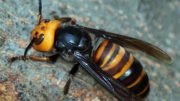
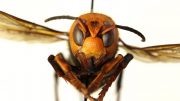
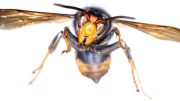
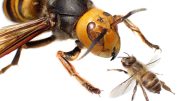

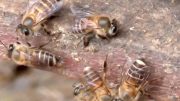
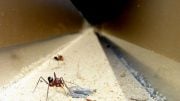
howdy-do, illustrious blog on fatlike loss. comparable helped.